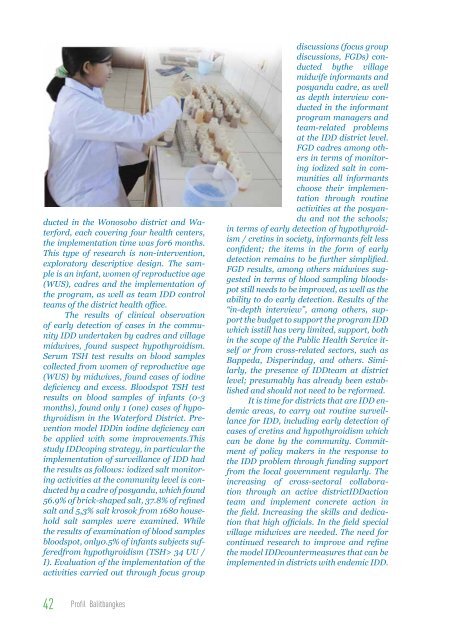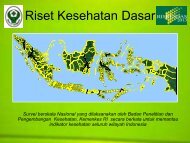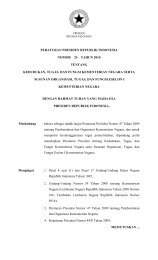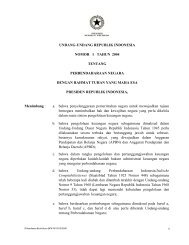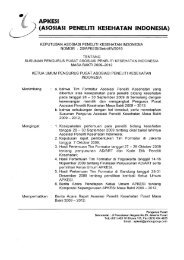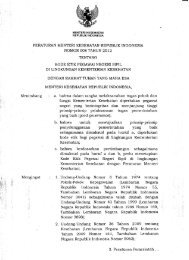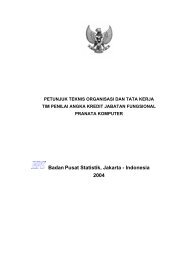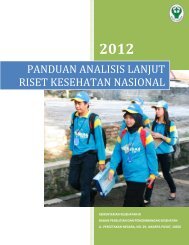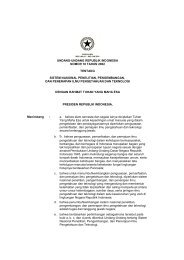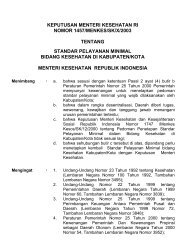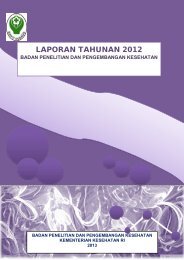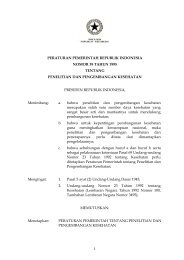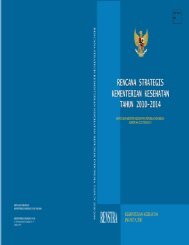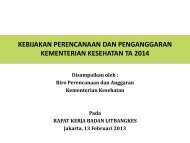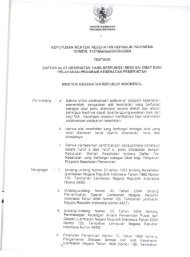Download Profil Badan Litbang Kesehatan 2012
Download Profil Badan Litbang Kesehatan 2012
Download Profil Badan Litbang Kesehatan 2012
- No tags were found...
You also want an ePaper? Increase the reach of your titles
YUMPU automatically turns print PDFs into web optimized ePapers that Google loves.
ducted in the Wonosobo district and Waterford,each covering four health centers,the implementation time was for6 months.This type of research is non-intervention,exploratory descriptive design. The sampleis an infant, women of reproductive age(WUS), cadres and the implementation ofthe program, as well as team IDD controlteams of the district health office.The results of clinical observationof early detection of cases in the communityIDD undertaken by cadres and villagemidwives, found suspect hypothyroidism.Serum TSH test results on blood samplescollected from women of reproductive age(WUS) by midwives, found cases of iodinedeficiency and excess. Bloodspot TSH testresults on blood samples of infants (0-3months), found only 1 (one) cases of hypothyroidismin the Waterford District. Preventionmodel IDDin iodine deficiency canbe applied with some improvements.Thisstudy IDDcoping strategy, in particular theimplementation of surveillance of IDD hadthe results as follows: iodized salt monitoringactivities at the community level is conductedby a cadre of posyandu, which found56.9% of brick-shaped salt, 37.8% of refinedsalt and 5,3% salt krosok from 1680 householdsalt samples were examined. Whilethe results of examination of blood samplesbloodspot, only0.5% of infants subjects sufferedfromhypothyroidism (TSH> 34 UU /I). Evaluation of the implementation of theactivities carried out through focus groupdiscussions (focus groupdiscussions, FGDs) conductedbythe villagemidwife informants andposyandu cadre, as wellas depth interview conductedin the informantprogram managers andteam-related problemsat the IDD district level.FGD cadres among othersin terms of monitoringiodized salt in communitiesall informantschoose their implementationthrough routineactivities at the posyanduand not the schools;in terms of early detection of hypothyroidism/ cretins in society, informants felt lessconfident; the items in the form of earlydetection remains to be further simplified.FGD results, among others midwives suggestedin terms of blood sampling bloodspotstill needs to be improved, as well as theability to do early detection. Results of the“in-depth interview”, among others, supportthe budget to support the program IDDwhich isstill has very limited, support, bothin the scope of the Public Health Service itselfor from cross-related sectors, such asBappeda, Disperindag, and others. Similarly,the presence of IDDteam at districtlevel; presumably has already been establishedand should not need to be reformed.It is time for districts that are IDD endemicareas, to carry out routine surveillancefor IDD, including early detection ofcases of cretins and hypothyroidism whichcan be done by the community. Commitmentof policy makers in the response tothe IDD problem through funding supportfrom the local government regularly. Theincreasing of cross-sectoral collaborationthrough an active districtIDDactionteam and implement concrete action inthe field. Increasing the skills and dedicationthat high officials. In the field specialvillage midwives are needed. The need forcontinued research to improve and refinethe model IDDcountermeasures that can beimplemented in districts with endemic IDD.42 <strong>Profil</strong> Balitbangkes


